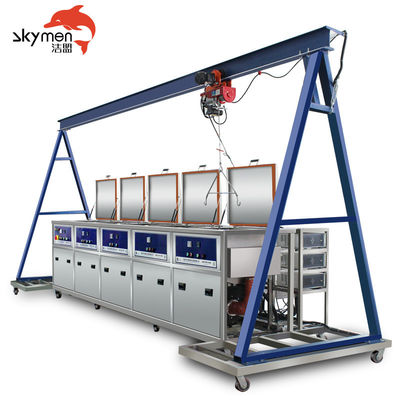Cleaning effect
Ultrasonic Cleaning Machine For Reactor
The reaction kettle is resistant to high temperature, corrosion, abrasion, and has strong production capacity. It is a container for physical or chemical reactions. It is widely used in medicine, dyes, petroleum, chemical, food and other industries to achieve process evaporation, heating, and cooling. And other functions, it is used to complete the process of vulcanization, nitration, hydrogenation, alkylation, polymerization and condensation reaction equipment. After the reactor is used for a period of time, it will become fouled, reduce the heat exchange performance, increase the reaction time, and aggravate the corrosion of the reactor equipment, so the reactor must be cleaned. The commonly used cleaning methods for reactors include chemical cleaning and mechanical cleaning. Chemical cleaning Choose the appropriate cleaning agent according to the dirt components in the equipment. This method can clean thoroughly and quickly remove dirt. However, it may cause corrosion to the equipment. This method is suitable for soft and thin dirt. Mechanical cleaning Use high-pressure water through the nozzle to flush and remove dirt. The cleaning cycle is long and time-consuming, but it will not cause equipment corrosion and can effectively clean hard dirt. Suitable for hard and thick dirt. Chemical + mechanical cleaning method Ultrasonic cleaning machine cleaning plus mild chemical cleaning agent can achieve the effect of quickly peeling thick dirt, and will not corrode the reactor equipment, will not cause damage to the equipment, and the cleaning efficiency is high.
Daily maintenance
1. Pay attention to the explosion-proof distance when installing the reactor. Multiple sets of reactor equipment need to be placed separately to ensure good ventilation.
2. When choosing heat transfer oil, be sure to choose the corresponding model, and no water can be added.
3. After the reactor is installed, the nitrogen pressure must be maintained first to ensure that there is no leakage before starting work. If a leak is found, use soap foam to find the leaking point of the nozzle and pipeline. After finding the leaking point, release the gas and tighten it, and then maintain the pressure with nitrogen.
4. Metal rupture discs cannot be adjusted at will. After the metal rupture disc is blasted, it needs to be replaced with a new metal rupture disc. When replacing metal rupture discs, pay attention to the convex surface of the rupture disc.
5. After the reaction is completed, cool down, and discharge the gas in the kettle to the outside through the pipeline, so that the pressure in the reaction kettle is reduced to normal pressure. Note that it cannot be disassembled under pressure. Then loosen and remove the main bolts and nuts, remove the kettle cover and place it on the bracket, and pay attention to protecting the sealing surface when removing the cover.
6. When cooling down, use water for internal cooling and avoid rapid cooling to prevent excessive temperature difference from causing cracks in the cooling coil and the kettle body. During the working process, the temperature in the reactor is higher than 100℃, and the water jacket and magnetic stirrer between the cover of the reactor need to pass cooling water. The water temperature is less than 35℃ to prevent the magnetic steel from being demagnetized.
7. When using the reactor, you need to close the refrigerant inlet valve, drain the refrigerant in the pot and jacket, then input the material, turn on the stirrer, then turn on the electric heating power and steam valve, turn off when the required temperature is reached, then turn off the stirring Device. After finishing, drain the remaining condensed water in the pot and jacket, rinse with warm water to remove the materials, and then use alkaline water to clean the inner wall of the container. When the boiler is empty, the steam valve and electric heating power supply shall not be opened, and the steam pressure shall not exceed the rated working pressure.
8. After the operation is completed, pay attention to the cleaning of the inside of the kettle. Use a cleaning solution to remove the residues on the reaction kettle and the sealing surface. Frequent cleaning is required to keep it clean. It is forbidden to clean with rough surface items.
9. Always pay attention to the working conditions of the entire reactor equipment and reducer, and replenish lubricating oil in time.
10. The electric heating medium oil must be replaced every six months.
11. Regularly check the safety valves, distillation holes, electric heating rods, pressure gauges, and electrical instruments in the jacket and pot cover and other parts, and repair them in time if they are found to be faulty.
12. When the reactor is not in use, wash the pot body frequently and clean the inner and outer walls of the container with warm water to keep it clean and make the equipment more durable

 Your message must be between 20-3,000 characters!
Your message must be between 20-3,000 characters! Please check your E-mail!
Please check your E-mail!  Your message must be between 20-3,000 characters!
Your message must be between 20-3,000 characters! Please check your E-mail!
Please check your E-mail! 







